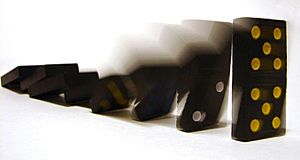Causality facts for kids
Causality is a way to understand how different events are connected. Imagine two events, A and B. If B happens because A happened, then we say A is the cause of B. And B is the effect of A.
It might sound simple, but understanding cause and effect can be tricky. Many thinkers have explored this idea. They have come up with different ways to explain it.
Contents
Understanding Cause and Effect
Aristotle's Four Causes
Aristotle was a famous Greek philosopher. He thought a lot about why things happen. He described four different types of causes:
- Material Cause: This is what something is made of. Think of it as the "raw material."
* Example: The bronze used to make a statue.
- Formal Cause: This is the plan or design of something. It's what gives a thing its shape or form.
* Example: The shape or design of the statue.
- Efficient Cause: This is what actually makes something happen or change. It's the "doer" or the force behind the change.
* Example: The artist who makes the statue, or the skill of working with bronze.
- Final Cause: This is the purpose or reason why something exists. It's why it was made or why it happens.
* Example: The reason the artist wanted to create the statue in the first place.
Aristotle's ideas helped people think about the many ways things can be caused.
David Hume's View on Causality
David Hume was another important philosopher. He studied how we understand cause and effect. Hume believed that for us to see a cause-and-effect relationship, a few things must be true:
- Close in Space and Time: The cause and effect must happen close to each other. If they are far apart, there's usually a chain of events connecting them.
- Effect After Cause: The effect always happens after the cause. The cause comes first.
- Constant Connection: We often see the same cause always leading to the same effect.
Hume suggested that our idea of cause and effect comes from habit. When we see one event (the cause) always followed by another (the effect), our minds get used to this pattern. So, when we see the first event, we expect the second one to follow. It's like our brains learn to connect them.
Causality in Logic
Logic is the study of how we build arguments and reason. In logic, we often talk about two main types of causes:
- Necessary Cause: A necessary cause means that if the effect (B) happens, then the cause (A) must have happened first. But just because A happens, B doesn't necessarily happen.
- Example: To be a United States Senator, you must be at least 30 years old. So, if someone is a Senator, they are definitely 30 or older. However, being 30 or older doesn't mean you are a Senator.
- Sufficient Cause: A sufficient cause means that if the cause (A) happens, then the effect (B) will definitely happen.
- Example: If a playing card has a large spade (♠) symbol in the center, that is sufficient to know it's an ace. You don't need to know about the other ace cards (diamond, heart, club). If you see the spade, it's an ace.
Related pages
General
See also
 In Spanish: Causalidad (filosofía) para niños
In Spanish: Causalidad (filosofía) para niños



